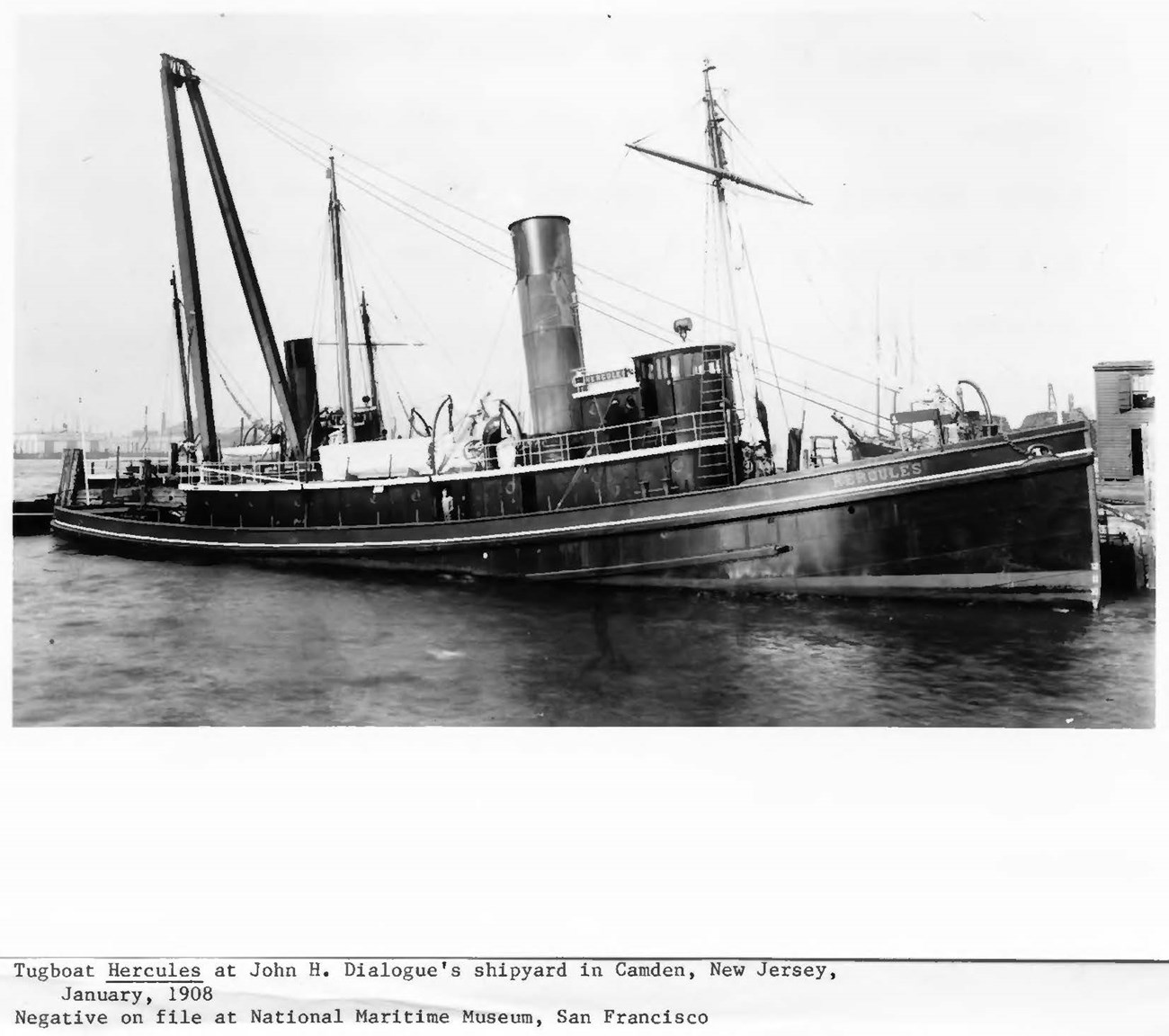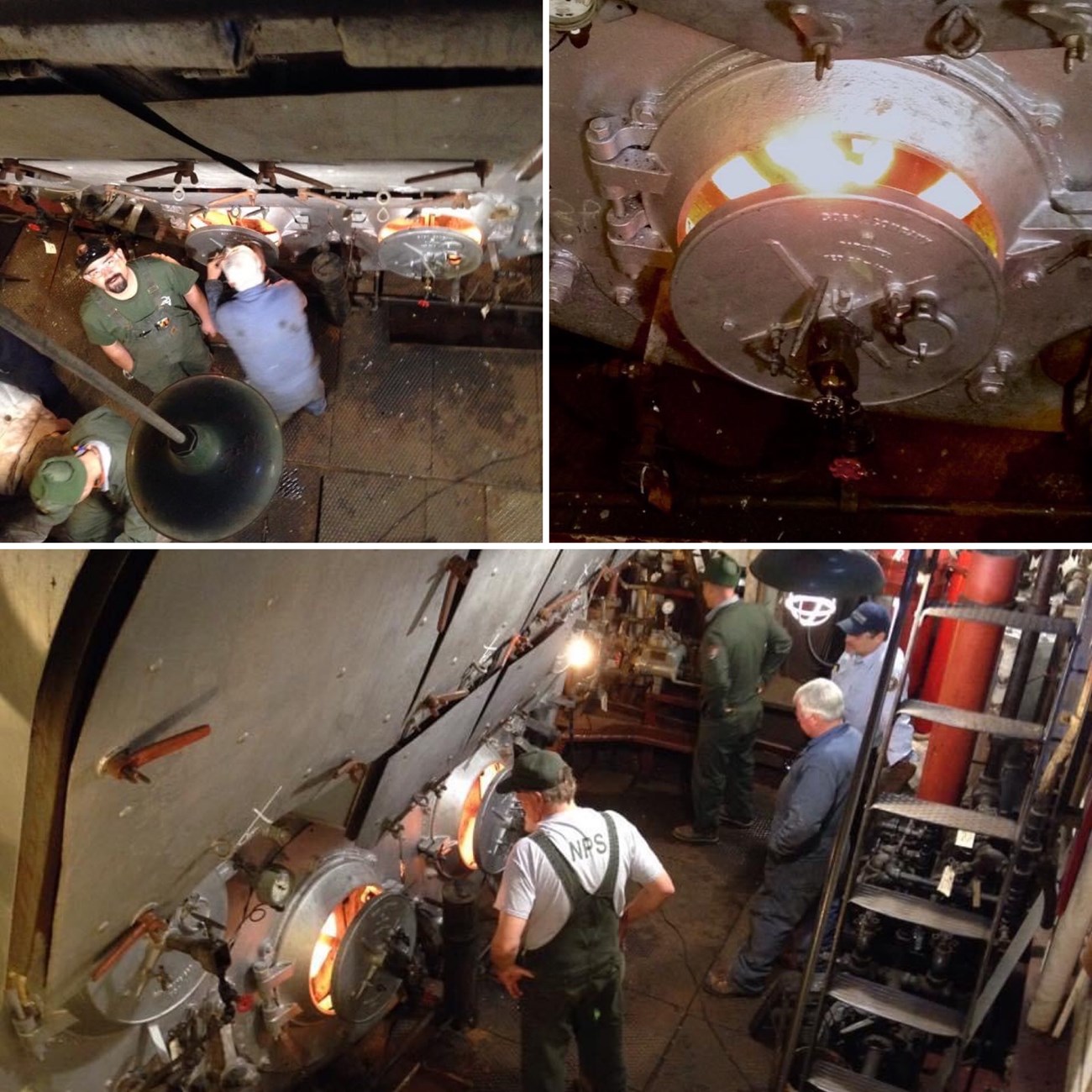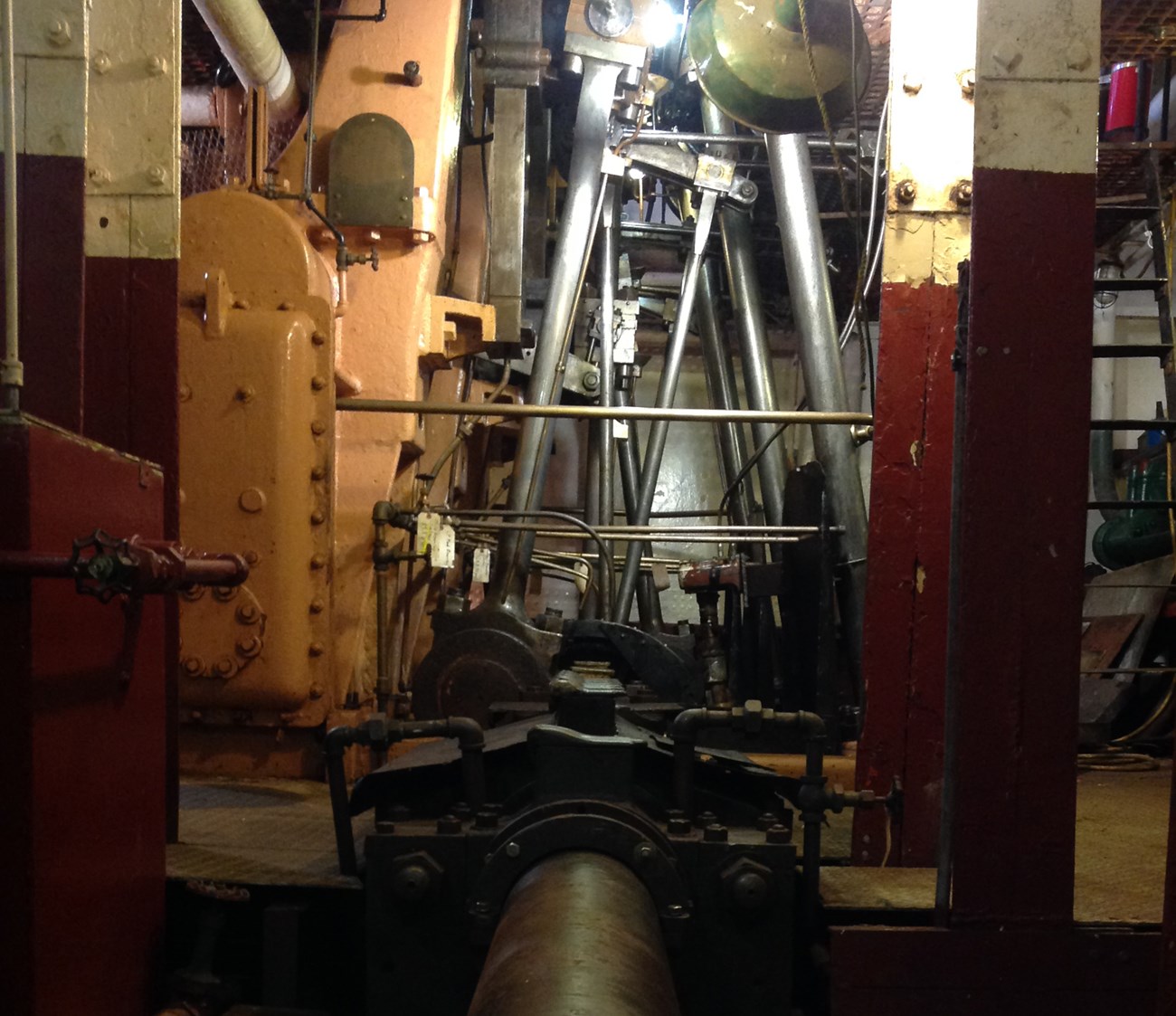
SAFR Image collections number: I0.7910pl Life and Work Below Deck on the Tug Hercules By Park Ranger Christopher Edwards Built in 1907 at the John H. Dialogue & Son Engineers and Shipbuilders Yard in Camden, New Jersey, the steam powered ocean going tug Hercules can often be a daunting subject for both staff and visitors of San Francisco Maritime National Historical Park. This is due to the perception that the subject of tugs is primarily technical. Some of the nick names for tugs such as “floating muscle,” “floating tow trucks,” and “an engine with a hull around it,” can certainly lend credence to this belief. However, the type of steam technology used on Hercules, along with her ocean going job, required a large crew to live and work in sometimes very difficult conditions on voyages that could last up to a month. Viewed in this way, the history of Hercules is as full of humanity as it is technology. Even the shape of Hercules’ hull is a blend of technical and human stories. From the outside, Hercules’ main deck has an extreme upward curve starting back aft, at the stern, where the deck is low and very close to the water, and rising to a great height forward at the bow. This characteristic is referred to as sheer. As a tug, Hercules’ stern needs to be low enough to the water so that when the tow cable is lead out and overboard, it will not have a great drop down to the water. The forward part of the main deck however, requires exactly the opposite. As an ocean-going vessel, Hercules needs to be able to ride over large waves that are encountered during storms. With her high bow, even if she buries it into a large wave, she will gain buoyancy and ride up and over it as opposed to through it or under it. Hercules’ curved deck also produces a human element. Specifically, the curved deck creates the internal space needed for the crew’s bunkroom. The crew’s living space, referred to as the forecastle (pronounced fo’c’sle), is a single compartment in the very bow of the tug averaging 18 feet long by 18 feet wide. This is home to approximately nine to twelve crew. In such cramped conditions, the crew are constantly surrounded by each others habits, smells, annoyances, and are likely to know everything about their shipmates, including much that they would prefer not to. Also, as the forecastle is in the forward-most part of the tug, this area is often subject to violent pitching and thunderous wave-pounding experienced during storms. This can make life for the crew extremely challenging. 
NPS He is calmed by his returned eyesight though, and his breathing slows to normal. Unfortunately he also notices a foul stench. The deck is covered with pools of vomit from several of his seasick shipmates, and with each violent roll and pitch of Hercules it spreads everywhere. In these heavy seas, all the ventilation is closed to keep water out, and the stench of vomit in the enclosed forecastle is potent. The smell is so strong and concentrated that he starts feeling sick himself. He knows that he too will shortly vomit and make his own contribution to the deck. It has only taken a few moments, but the ocean has completely stolen his sense of self-control. “Just a moment stillness,” he pleads to the storm. But the storm rages on. This combination of misfortunes was not uncommon. Bad storms could go, without respite, for days at a time. Combined with injury and sickness, these storms resulted in extreme crew discomfort and a sense of helplessness. Despite these difficult living conditions, there is one architectural feature that enhances safety for the crew: an internal passageway that runs along the main deck. This passageway runs from the forecastle all the way back aft to the engine room. During a storm with all the exterior doors shut, this was a claustrophobic route. However, as many sailors can be lost by being washed overboard from their vessels, Hercules’ crew looked upon her interior passageway as a protective blessing. In rough weather, it protected them from an otherwise perilous journey along Hercules’ wave-swept exterior decks. Despite being protected from the dangers outside, however, work within Hercules also presents many perils. For example, how does one care for a potential bomb? Imagine being a passenger on board Hercules, perhaps as a privileged guest of the Captain. You have been given permission to roam around the tug, and you find yourself in a room standing on a metal grating looking down. You see a massive object down below producing a very low pitched hum. From where you are on the grating, however, it is hard to appreciate what this humming juggernaut is meant to do. It seems to be no more than a two-story tall cylinder lying on its side. It has no moving parts, but it is radiating a tremendous amount of heat along with its low pitched hum. Climbing down the long ladder, you gain a sense of terrible possibility. You see four big furnaces along its bottom, blazing fire within. Reaching the bottom of the ladder, you see only one crewman on watch in this Hades-like place. He calls himself a fireman, and he is busy not only with the furnaces, but also with several other items that you suddenly notice along the periphery of the room. He reaches over what appears to be a pump, and turns a valve counter clock-wise. Suddenly the pump speeds up slightly. The fires in the furnaces brighten, and you realize that these pumps are for fuel. You jump with surprise as a tube shrieks the sound of a whistle. The previously calm fireman dashes over to the offending voice tube, removes the beckoning whistle, and shouts “Boiler room!” 
NPS “How’s your water?!” demands the voice from the tube. “Stand-by” replies the suddenly panicky fireman who hastens over to one side of the boiler and stares up at a glass tube. Mounted on the side and near the top of the boiler, this glass tube is filled with water and steam. The fireman notes with alarm that the water level is dangerously low in the tube. He sprints to the other side of the boiler, deck plates clanging under foot. He reaches down to a valve which he opens nearly all the way. He hurries back to look again at the glass tube. With relief, he notices that the water level is back within safe limits. However, he knows that the voice in the tube, the engineer in the engine room, is going to want to know what happened. Through the voice tube, the fireman contacts the engine room and makes his admission to the engineer. “I let the water level get too low,” he says. “But I’ve opened the feed water valve, and the situation is now okay.” The fireman waits for the response which is predictably irate. “Do you want to get us all killed!!!” shouts the voice through the tube. “Do I need to remind you that if the water level get’s too low, you can cause an explosion that would tear this tug to pieces?!!!” The shouting rages on for a little longer, but you suddenly understand, with alarm, what almost happened. Just a moment ago, you felt proud at having figured out that this cylindrical behemoth is a boiler, and that its function is to produce all the steam power needed on board. But you did not realize how great the fireman’s responsibility really was. Even without full knowledge of how the boiler works, you now understand that if the fireman does not perform his duties with great care, this juggernaut could quickly turn from a boiler into a bomb. One oversight by the fireman, such as a low boiler water level, could destroy Hercules and everyone on board in huge explosion of smoke and scalding steam. 
NPS At times this job is extra hazardous and stressful. This would be true during a storm like the one described above. Imagine an oiler’s journey to the engine room and his day at work during this storm. Going on watch, he would emerge from the fo’c’sle and make his way through the tug. As he walks, he leans alternately to port and starboard then forward and backward in an effort to stay upright, despite the tossing deck beneath his feet. He emerges onto the mezzanine at the forward end of the engine room and gazes down onto a two story tall engine that is churning and hissing with the passage of steam. He sees the engine room crew, and seemingly the engine itself, struggling to stay upright as mountains of water attack the tug from without. He climbs down the ladder, relieves the oiler of the previous watch, and proceeds to make his first round. To gain some stability he raps his arms around one of the engine’s support legs. 
NPS He returns his attention to the engine. He must get on with the business at hand. He hears the hiss of the steam within the engine, and the ‘chug, chug, chug’ of the turning cranks. He breaks out in a cold, nervous sweat, and his stomach tightens into a knot at the thought of what he must now do. He looks for a way to better stabilize himself so he can safely touch those cranks, but there seems to be no easy way. “Am I sure I can do this?” the oiler hesitatingly thinks. Even in calm weather, this job is not for the faint of heart. He knows many people who are missing fingers as a result of a misplaced hand. In this weather, though, he’s worried about losing a limb or even his life. He clenches his jaw, steels himself, and very carefully stretches his arm down towards the churning crank. “Slowly” he says to himself “Do… everything… deliberately.” Pouring cold sweat down his temples, he slowly, and waveringly, inches his hand forward. And then…. contact!! The crank has swiped over the top of his hand. He whips his hand away and resumes his death-grip hug of the engine support. Looking at the oil that came off from the crank and onto his hand, he sees that the oil is a bluish color. Not black. “Thank God,” he breaths. “This crank is doing fine.” But, he still has two other cranks to go, and the watch is far from being over. “Well done!!” booms a voice from above. Startled, the oiler looks up through the metal gratings and sees the chief engineer. The chief had been watching him the whole time! “This is one of the worst storms that I have been through,” says the chief. “Don’t worry… you’ve got the guts for this. Keep up with what I just saw you do, and you’ll get through this watch just fine.” Slightly dumbfounded by this praise from the chief engineer, the oiler found himself mustering only a simple and weak “Thanks chief.” A good officer, like the chief engineer, knew when a dose of praise was needed. In this case, it was very much deserved. This job, like the subject of Hercules’ architecture, is a technical requirement for operating Hercules. However, when looking at its physical demands and the influence of a storm at sea, the story of an oiler takes on a whole different feel. From the oiler’s perspective, his job could be outright frightening. This job, indeed, required a great deal of bravery and skill. More than anything, Hercules tells a story of technical history constantly impacting and defining her human history. Her seaworthy architecture and machinery requirements defined the amount of space and privacy for the crew. The boiler and main engine defined the demands and hazards of the work experience. And the ocean environment, especially storms, could change the on-board experience from a pleasant cruise to a nightmare struggle for survival. |
Last updated: October 5, 2024
